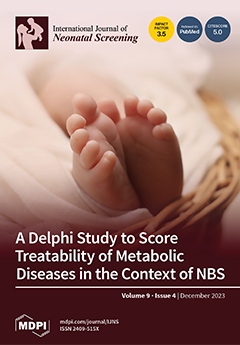Open AccessArticle
A Newborn Screening Program for Sickle Cell Disease in Murcia (Spain)
by
María Sánchez-Villalobos, Eulalia Campos Baños, María Jesús Juan Fita, José María Egea Mellado, Inmaculada Gonzalez Gallego, Asunción Beltrán Videla, Mercedes Berenguer Piqueras, Mar Bermúdez Cortés, José María Moraleda Jiménez, Encarna Guillen Navarro, Eduardo Salido Fierrez and Ana B. Pérez-Oliva
Cited by 5 | Viewed by 2849
Abstract
Sickle cell disease (SCD) is an inherited autosomal recessive hemoglobin disorder caused by the presence of hemoglobin S, a mutant abnormal hemoglobin caused by a nucleotide change in codon 6 of the β-globin chain gene. SCD involves a chronic inflammatory state, exacerbated during
[...] Read more.
Sickle cell disease (SCD) is an inherited autosomal recessive hemoglobin disorder caused by the presence of hemoglobin S, a mutant abnormal hemoglobin caused by a nucleotide change in codon 6 of the β-globin chain gene. SCD involves a chronic inflammatory state, exacerbated during vaso-occlusive crises, which leads to end-organ damage that occurs throughout the lifespan. SCD is associated with premature mortality in the first years of life. The process of sickling provokes asplenia in the first years of life with an increased risk of infection by encapsulated germs. These complications can be life-threatening and require early diagnosis and management. The most important interventions recommend an early diagnosis of SCD to ensure that affected newborns receive immediate care to reduce mortality and morbidity. The newborn screening program in the region of Murcia for SCD began in March 2016. We aimed to determine the incidence of sickle cell anemia and other structural hemoglobinopathies in the neonatal population of the region of Murcia, an area of high migratory stress, and to systematically assess the benefit of newborn screening for SCD, leading to earlier treatment, as well as to offer genetic counseling to all carriers. The prevalence of SCD in our region is similar to others in Spain, except for Catalonia and Madrid. The newborns with confirmed diagnoses of SCD received early attention, and all the carriers received genetic counseling.
Full article
►▼
Show Figures






